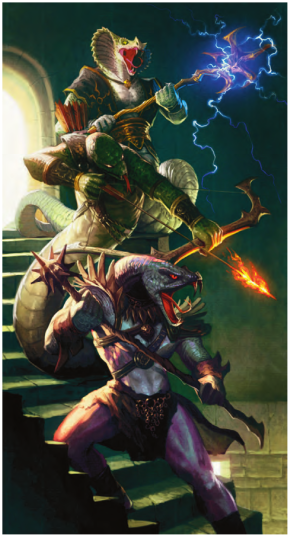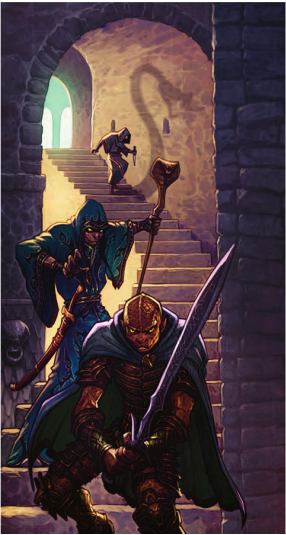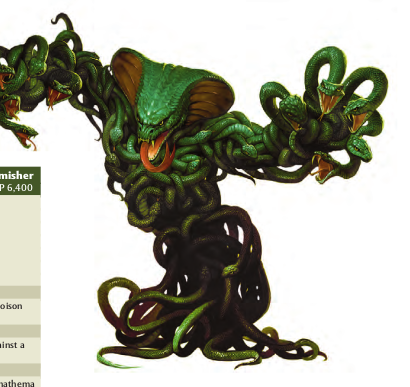Let's Read The 4e Monster Manual/Vault: Yuan-Ti

This article is part of a series! Click here to see the other entries.
Yuan-ti have been in the game since AD&D 1st Edition. Here, they are both in the Monster Manual and in the Vault.
The Lore
Yuan-ti lore has gotten more and more elaborate since their first appearance, and by Fourth Edition it’s quite something. The Monster Vault has a doozy of an origin story for them.
Back when the world was young, and the gods were still creating the mortals that would inhabit it, the snake god Zehir found out he couldn’t make his own mortals. So, being sort of treacherous asshole you’d expect a D&D snake god to be, he decided to steal some.
To that end, he seduced Avandra and tried to convince her to teach him how to reshape mortals created by other gods. Being in love, Avandra accepted. Not being a fool, she attached an extra condition to this power: Zehir could only use it if the god that presided over the mortals in question gave him explicit permission.
Of course, Zehir was a lot more of an asshole than Avandra suspected. When the Dawn War was over, and the other gods were all weakened from all the fighting, Zehir murdered the god of humanity. And now he had a whole mortal species to mess with at will, no permission required.
Zehir took many humans and changed them into creatures whose shape pleased him. These became the yuan-ti, his chosen people. They, in turn, built the mighty empire of Zannad, which ruled over the whole world. From what I can piece together from the other entries, the time of Zannad was after the fall of the giants but before the rise of pretty much anyone else. Depending on how you classify giants, you could even call Zannad the first mortal empire.
Eventually the surviving gods regained their strength and slapped Zehir around until he relinquished his control over humanity. Though they argued for a while over who would take custody of their souls after this, they never managed to come to an agreement. And this is why the humans of today have the potential to be both the most virtuous and the most corrupt of mortals: by default, their souls belong to no god.
Slavery was the foundation upon which Zannad was built, and it fell when its innumerable slaves successfully rebelled against their masters. The yuan-ti of today are descended from those who survived Zannad’s fall, and in their minds there is no greater aspiration than to rebuild their former empire in all its cruel glory. The way the book describes it, they have a much better chance of achieving this goal than the giants.

Throughout most of the world, the yuan-ti live in secret amid the other mortal peoples and conspire to take over their power structures. They head secret cults of Zehir and bestow minor reptilian transformations upon their human lackeys as rewards for loyalty. These people are known as “snaketongue cultists”. Some get inducted and transformed because they’re the sort of people who agrees perfectly with Zehir’s philosophies. Others get kidnapped and transformed first, and then convinced they must serve the god that “marked” them.
Yuan-ti conspiracies are many and varied, and in a lot of places people don’t even know they exist at all. In other places, they already got to the point where they can rule openly, such as in Zahnshahan, the Slithering City. These serpentine city-states engage in trade and diplomacy much like any other mortal realm, but their ultimate goal is always the subjugation of their neighbors.
The Numbers
Most Yuan-ti are Medium Natural Humanoids with the Reptile keyword. They have Resist Poison 10, and a natural speed of 7. All of their other abilities are the product of training, so they vary a lot per stat block. These start at mid-Paragon tier and go up from there, so by the time the PCs meet yuan-ti in person they’ve likely worked their way through the bottom rungs of their conspiracy pyramid.
Snaketongue cultists are Medium Natural Humanoids, more specifically humans. Their minor mutations aren’t enough to give them the Reptile keyword or any special powers beyond what they get from training. Like their masters they rely both on their skill at arms and on any snake-and-poison-themed magic they might have gained through arcane study or devotion to Zehir.
Cultists are more or less equivalent to the near-human “purebloods” of earlier editions, and I guess that name was dropped because it was confusing (“why is the least snaky variety named like that?”). 5e would adopt the name again and make yuan-ti backstory even more elaborate in order to justify it.
The Monster Vault mentions the existence of snaketongue cultists but doesn’t have stat blocks for any, though of course any human stat block can be used with a few tweaks.
Yuan-ti Malison Sharp-Eye (Both)
“Malison” is what the most common variety of yuan-ti is called. They’re pretty much your standard Serpent People. Some have legs, some have snake bodies, but all are equally mobile.
Sharp-eyes are Level 13 Artillery with 98 HP. They wield a scimitar in melee and a longbow at range, and they ideally want to stay far away from the opposition because their Chameleon Defense gives them partial concealment from enemies more than 3 squares away.
The arrows from the longbow are envemomed - a hit with them triggers a secondary attack vs. Fortitude, which does ongoing poison damage and dazes (save ends).
Yuan-ti Malison Stalker (Monster Vault)
Stalkers are Level 13 Skirmishers with 126 HP. They wield morningstars with interesting riders: a hit prohobits the target from marking anyone for a turn, and does ongoing poison damage (save ends).
They can also throw poisoned daggers (Ranged 10 vs. AC) which do a bit less physical damage but also have an ongoing poison damage rider (save ends). Their at-will slither strike allows them to end any mark currently on them, shift 4 squares and make a dagger or morningstar attack at any point along the movement.
Looks like stalkers are effective at shutting down a PC defender’s ability to, well, defend. They can move past the party’s front-line and target the PCs in the back, or flank said front-line to allow their own squishies to move away unimpeded by marks.
Yuan-Ti Abomination (Both)

This is a Large yuan-ti warrior that seems to always have a snake’s lower body. It’s a Level 14 Soldier with 140 HP who fights with a bastard sword and a shield.
The sword marks for a turn and does ongoing poison damage (save ends). The abomination can use a minor action to grab a victim using its grasping coils (melee 2 vs. Reflex), and it can bite a grabbed victim as its attack. This does more damage than the sword, both immediate and ongoing.
Yuan-Ti Malison Chanter (Monster Vault)
This spellcaster is likely a priest of Zehir. It’s Level 15 Artillery with 118 HP. While bloodied, its Bloody Scales trait grants it a +2 bonus to speed and to all defenses.
The chanter fights in melee with a bite that also causes ongoing poison damage (save ends), and at range with a Mind Warp spell (ranged 20 vs. Will) which does a bunch of psychic damage and inflicts a -2 penalty to attacks for a turn. It can also use Poisoned Domination (ranged 20 vs. Will) against a target taking ongoing poison damage, dominating it for a turn. This is an encounter power that recharges when the chanter is bloodied.
If hit by a melee or ranged attack, the chanter can use Deflect Attack (recharge 4-6) to have it hit an adjacent ally instead. So make sure to surround the chanter with lots of cultists!
Yuan-Ti Malison Incanter (Monster Manual)
As the name hints, this is basically the same monster as the Chanter above, but it’s stat block is different enough it warrants a separate entry.
The Incanter has the same level, HP, and bite as its Vault counterpart, but all the other abilities are different. It has a Zehir’s Shield aura (10) that gives all allies a +2 bonus to all defenses. Mind Warp dazes (save ends) instead of inflicting an attack penalty. Poisoned Domination has a shorter range (5) and has a daze (save ends) after-effect. Bloody Scales is replaced by Slither Away, which is similar but grants a +5 to all defenses instead of a +2.
There’s a new attack too, Zehir’s Venom (ranged 10 vs. Fortitude; recharge 4-6) which is almost exactly identical to Mind Warp but does poison damage instead of psychic. Deflect Attack triggers a little less often (recharge 5-6).
So, in short, this is a much more complicated version of the monster, that’s much more annoyong to fight.
Yuan-ti Malison Disciple of Zehir (Monster Manual)
What a mouthful of a name, eh? This is a Level 17 Controller with 164 HP. It projects Zehir’s Favor as an aura (10) which heals allies inside for 5 HP per turn and does 5 poison damage per turn to enemies.
The disciple fights with a morningstar that has a secondary attack vs. Fortitude to inflict ongoing poison damage (save ends). This does stack with the aura damage. It will also very often whisper Soothing Words (Ranged 5 vs. Will; recharge 3-6), which dominate (save ends) and have a daze (save ends) after-effect.
Yuan-ti Anathema (Monster Manual)

Anathema used to be the sovereign rulers of the yuan-ti back in the bad old days, but something happened to drive them mad and turn against their subjects. Now they are kept imprisoned, and the other yuan-ti placate them with sacrifices dropped from a safe distance. This is both out of reverence for Zehir and out of fear that the anathemas will escape their prisons and eat the world.
These snakes-made-of-snakes are Huge Natural Magical Beasts with the Reptile keyword. They’re also Level 21 Elite Skirmishers with 412 HP. Their poison resistance is 20, and their speed is 8.
Their basic attack is a slam that also does ongoing poison damage (because snakes). They can make two of these per action. They can also bite, which does a bit more damage than a single slam and triggers a secondary attack vs. Fortitude. This does more ongoing poison damage than the slam, and inflicts a -4 penalty to attack rolls (save ends both).
The anathema can trample, moving its speed through enemy spaces (subject to opportunity attacks) and making a special attack against vs. Reflex against each one that does damage and knocks them prone. It can also make its horde of snakes lash out at the same time (close burst 1 vs. Fortitude), doing physical and ongoing poison damage to those it hits.
If it cares more about moving than about doing damage, the anathema can disperse into a swarm of snakes, shifting its speed and reforming at the end of the movement. This also recharges Horde of Snakes.
In short, after you’ve cleared the yuan-ti headquarters at the end of paragon tier, you’re going to discover a whole other dungeon level filled with these things and other monsters like them.
Snaketongue Cultist Minions (Monster Manual)
We have two cultist minions here: the Level 7 Initiate, and the Level 12 Zealot, which seem to be skirmishers and are pretty much identical. They have speed 6 and fight with greatswords that do minion-scale damage and have the same “secondary attack/ongoing poison damage” rider some of their bosses display.
Snaketonge Warrior (Monster Manual)
The non-minion version of the cultists discussed above. It’s a Level 8 Brute with 106 HP, and its greatsword attack is a non-minion version of the one described above.
Snaketongue Assassin (Monster Manual)
This Level 9 Lurker has 80 HP and uses a poisoned dagger to fight. It suffers from the “naturalistic design” flaw, but has a “healthy” dose of ongoing poison damage on a hit.
To protect itself, it uses Crowd Shield tactics, gaining a +2 to AC and Reflex if it’s adjacent to one creature, or +4 if it has two or more. Interestlingly, the assassin can also use a move action to assume Serpent Form, transforming into a Crushgrip Constrictor and using all of its stat blocks except for HP, which retains its current value.
Snaketongue Celebrant (Monster Manual)
The bad guy your players fight just before discovering yuan-ti are behind it all. This is a Level 11 Controller with 117 HP. It fights with a Scimitar in melee that has the same secondary poison attack mechanic as the other weapons here. At range it can use a Serpent Lash spell (ranged 5 vs. Will; recharge 4-6) to do psychic damage and force the target to grant combat advantage for a turn. Coils of Despair (area burst 5 within 10 vs. Reflex; recharge 5-6) does no damage but restrains (save ends) and is likely to affect all the PCs at once.
Like the Assassin, the Celebrant can also use Serpent Form to turn into a crushgrip constrictor. In this case you might want to give a +2 to attacks, damage and defenses to the snake form in order for it to match the human form’s level.
Sample Encounters and Final Impressions
The list of Monster Manual sample encounters tries to tell us why it did have to be snakes. There are four encounters:
-
Level 9: a whole bunch of snaketongue cultists and their pet flame snake.
-
Level 11: An abomination, a sharp-eye, and more cultists.
-
Level 16: A disciple of Zehir, an incanter, and 2 shadow snakes.
-
Level 22: 2 dark nagas and an anathema. So now you know what the dark nagas guard.
Wow, that sure was a whole lot of snek. If that wasn’t enough for you, you can also include medusas, since their entry says they some times work together with yuan-ti.
I never really gave yuan-ti much thought, but the whole Zannad backstory here is compelling, and it makes them have a lot in common with Lovecraft’s Serpent Folk.